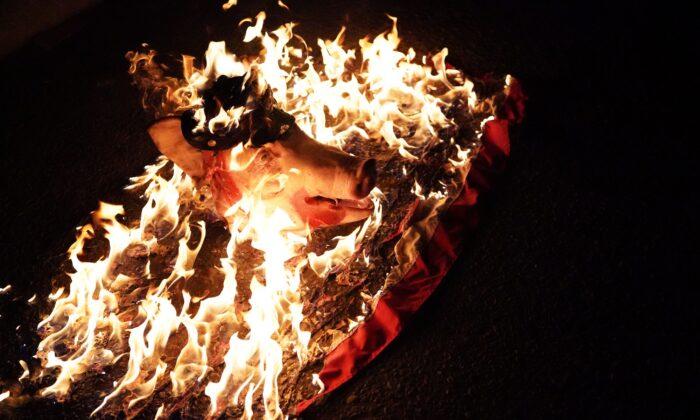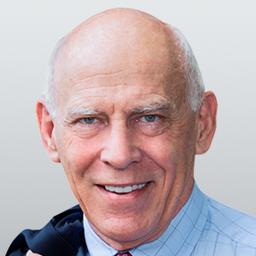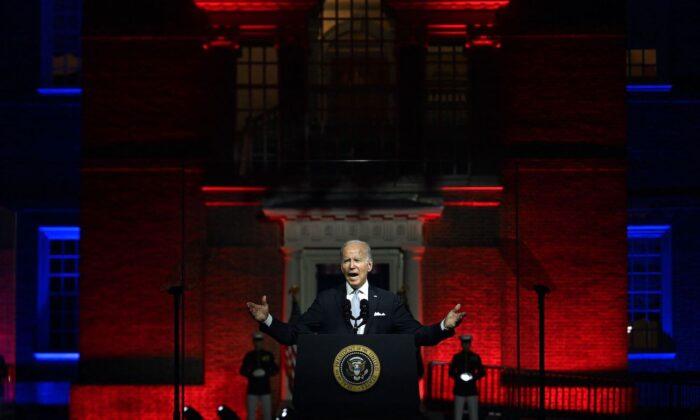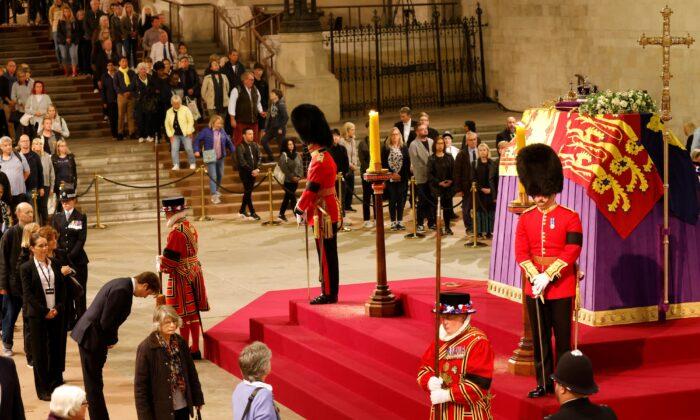Commentary
The protests and riots of the last two months have produced an unstable alliance of groups with different aims.
Some want to use the universal revulsion at the killing of George Floyd to protest police brutality and injustice and to reform the police. Others want to dismantle the police altogether, and to burn down every police precinct in the country.
Still others want to ensure a Democratic victory in November and to ensure that President Donald Trump is blamed for whatever happens in the interim—and then to retire the whole movement like Occupy Wall Street evaporated or #MeToo and its slogans disappeared overnight once it got too close to Joe Biden.
Since the 1960s, police forces have become more professional and better trained. There’s probably not a cop on the street, let alone a commanding officer or union leader, who didn’t deplore the horrific death in custody of a black man, George Floyd, in Minneapolis. It was the trigger for an explosion of anti-police sentiment in major cities across the country.
Heather Mac Donald
describes the looting, vandalism, and rioting that followed:
“On the night of Thursday, May 28, Minneapolis Mayor Jacob Frey ordered the city’s Third Police Precinct evacuated as the forces of anarchy descended upon it for a third day in a row. The building was promptly torched, sending a powerful sign that society would not defend its most fundamental institutions of law and order.
“Soon cities across the country became scenes of feral savagery. The human lust for violence, the sheer joy of plunder and destruction, were unleashed without check. Police officers were shot at, run over, slashed with knives, and clubbed; two current and former law enforcement officers were killed in cold blood. Police cruisers and station houses were firebombed; courthouses were trashed. Looters drove trucks through storefronts and emptied the stores’ contents into the back of these newly repurposed vehicles of civil war. ATMs were ripped out of walls; pharmacies plundered for drugs.”
Revolutionaries and Reformists
Two months later, the riots continue in several cities across the country. The demand emerged under the leadership of a Marxist-inspired, corporate-funded organization called Black Lives Matter (BLM), to “Defund the Police!” What does it mean? Among the revolutionaries of BLM and Antifa, it meant what it said; it was what Marxists call a transitional demand, one that serves an agitational purpose in a current situation while linking it to the goal they share as revolutionary socialists, the weakening and overthrow of capitalism.The demand aims not to reform the police forces in order to reduce abuse or to enable them better to serve and protect the residents of the community by maintaining law and order. It’s a demand aimed at the heart of the society the Marxists and anarchists seek to destroy.
As the Bolsheviks understood it, there’s a crucial distinction between the police and the army. It’s the revolutionary’s task to win over soldiers and gain their sympathy for the revolution. In the case of the police, however—those forces of the state that directly confronted poor and working people in their towns and cities—the task was to beat them up and kill them.
To the extent that the demand is met and the police weakened, the forces of revolution are strengthened.
This revolutionary motivation might be clear and explicit among the most violent of the anti-police groups, such as
Antifa, and the Marxist-inspired leaders of
BLM. But many others have participated in or cheered on the protests without aiming to wound or kill police officers.
The legacy media like The New York Times have minimized or failed to cover at all the violence of the protests, which they describe as “mostly peaceful.” But a recent weekend of urban anarchy in Portland involving 5,000 or 6,000, in which rioters
threw Molotov cocktails at federal officers, fired commercial-grade mortar fireworks at them, used lasers to target their eyes, and injured more than 20 with fireworks and projectiles, is not by any stretch the peaceful dissent the liberal media present it as.
It’s true that many people participated in or cheered on the protests for reasons that have nothing to do with revolution. They wanted to express their shock and repugnance at the way George Floyd died and to make sure policing is reformed so that such a horror is never repeated. These are the peaceful protesters, the “wall of moms,” that Antifa
places in the front lines of the demonstrators, a kind of human shield from behind which they launch their projectiles at the police.
The Portland Problem
The continuing riots and protests in Portland and elsewhere are now a problem for the Democrats who seek to win the presidency in November by blaming everything on the president while absolving of all responsibility the (Democratic) mayors responsible for the police and for law and order in their cities. They have been supporting or covering for the revolutionaries whose goals they do not share.
Now this strange coalition includes on one side the mostly urban and suburban white middle class kids, those who, as Victor Davis Hanson
describes them in National Review, are, many of them, in college, graduated, or dropped out. They make up Antifa and its affiliates. These are the shock troops, the ones who “seem to organize the statue toppling, graffiti, and vandalism, as well as the violence at the demonstrations.”
Like the revolutionaries of previous upheavals—the Jacobins, or Bolshevik leaders, or the revolutionaries of the Arab Spring—they reflect an overproduction of elites, an excessive expansion of higher education in a world that did not need so many lawyers, Hanson says. Such skills or credentials as today’s Jacobins acquired did not render them employable.
As Hanson puts it, they are “the new superfluous elite, in that their college investments brought them neither prestige nor money, but only debt and sloganeering memorized from the sermons of their tenured and comfortable lounge professors. History shows that when would-be, self-important elites are in surfeit and extraneous, they grow volatile.”
The Dilemma for Democrats
The revolutionaries serve a useful if temporary function for the Democrats insofar as the party and its media are able to pin the blame for the mayhem on Trump and present themselves as the agents of a return to order and stability once Biden is elected.But that line is less persuasive each day the riots continue. Concern for black lives and police misconduct, a concern shared across the political spectrum, has less and less to do with the protests and riots. At the same time, the nature of the rioting as a
criminal enterprise rather than peaceful protest is inescapably obvious.
The leader of Portland’s NAACP, writing in the
Washington Post, described his city’s two months of nightly protests as “white spectacle” and as having been co-opted by groups with their “own agendas”—“What are antifa and other leftist agitators achieving for the cause of black equality?”
A black Portland police officer commented that there were more blacks and minorities on the line with him than among the demonstrators. U.S. Congressman Jim Banks (R-Ind.)
said protesters concerns covered a wide range of more or less unrelated issues, such as Medicare for All, climate change, immigrant rights, and homelessness. Concern for black lives and the mistreatment of George Floyd was not prominent among them.
The demand to “defund the police”—and so make poor black lives even less safe, leaving residents at the mercy of “informal policing” by violent gangs and drug dealers—is not one that appeals to many blacks, even where there is anger and distrust toward police officers. It’s a slogan that affluent liberals in low-crime neighborhoods can endorse enthusiastically without feeling their safety is at risk.
But, as Jill Leovy graphically
shows in her study of murder in the ghetto, blacks who live in poor neighborhoods have long suffered from neglect and the underfunding of police. Further police reform is needed, but too often takes the form of misguided initiatives that are ineffectual or overzealous, treating law-abiding citizens as criminals while neglecting the task of solving serious crimes.
When the police withdraw or are pulled back from solving serious crime in high-crime neighborhoods in response to highly publicized inquiries and waves of anti-police sentiment, crime rates surge and violence increases, especially the rate of
black-on-black homicide, the main victims of which are young black men.
The failure of the Democrats in this area—where they control the police forces of the major cities—to do more than pass the buck becomes ever more evident. They fail to address long-standing issues within the cities or among police forces they control, to restore order and protect citizens, or even to acknowledge the violent nature of the riots that
all can see on their screens on a nightly basis.
The extent to which the millions of dollars donated to BLM by corporations and individuals are well spent looks increasingly questionable, whether the money goes to support Democratic Party candidates in elections or revolutionary socialists in the streets.
Paul Adams is a professor emeritus of social work at the University of Hawaii and was a professor and associate dean of academic affairs at Case Western Reserve University. He is the co-author of “Social Justice Isn’t What You Think It Is” and has written extensively on social welfare policy and professional and virtue ethics.
Views expressed in this article are opinions of the author and do not necessarily reflect the views of The Epoch Times.





